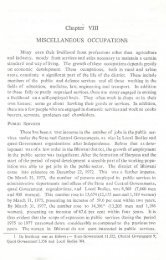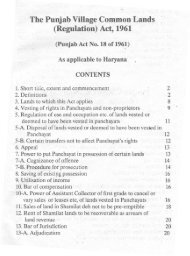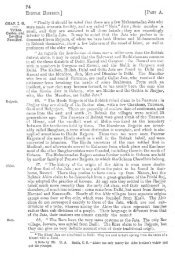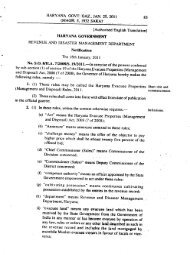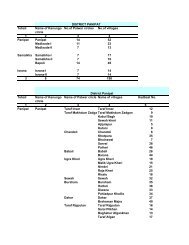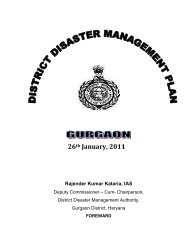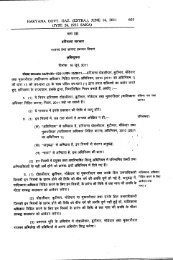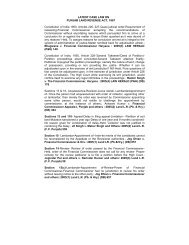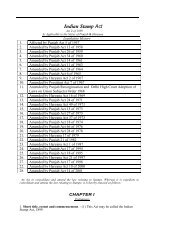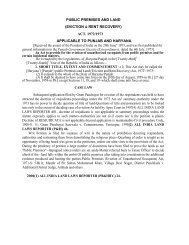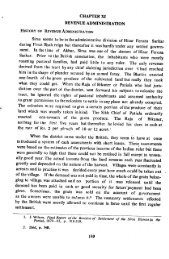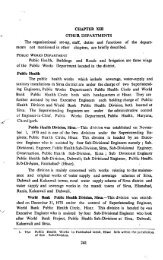CHAPTER V INDUSTRIES Sirsa has remained an industrially ...
CHAPTER V INDUSTRIES Sirsa has remained an industrially ...
CHAPTER V INDUSTRIES Sirsa has remained an industrially ...
Create successful ePaper yourself
Turn your PDF publications into a flip-book with our unique Google optimized e-Paper software.
The district <strong>remained</strong> <strong>industrially</strong> backward mainly due to unfavourable """<br />
geographical conditions, lack of communications <strong>an</strong>d scarcity of basic raw<br />
materials. However, by 1916, three cotton ginning factories had been<br />
established at M<strong>an</strong>di Dabwali besides a railway locomotive workshop at<br />
Slfsa.1 The setting up of cotton ginning factories further encouraged the<br />
production of cotton in the area <strong>an</strong>d also served as <strong>an</strong> impetus f()r industrial<br />
development.<br />
" In 1947, the number of small-scale industrial units in the district was<br />
only 9 with <strong>an</strong> investment of Rs. 64 thous<strong>an</strong>d <strong>an</strong>d providing t-~loyment<br />
to 16 persons. There was, however, no large scale industrial unit. During<br />
the period from 1947to 1966, the number of small-scale iRdustrial.units ~t up<br />
was 107 with <strong>an</strong> investment of Rs. 1.6 crore <strong>an</strong>d providing employmetlt<br />
to 1,37.8 persons. During the period from 1966 to 1976, the number of such<br />
units set up was 290 with <strong>an</strong> investment of Rs. 3.13 crore <strong>an</strong>d !,£oviding<br />
employment to 2,327 persons. In March 1981, there were 1,160 small-scale<br />
units. with a capital investment of Rs. 6.80 crore providing. employrn,ent to<br />
6,232 persons. Besides, there was a considerable number of uRits~hich were<br />
not registered .<br />
. Large alld medium scale units came into existence in the district only<br />
during sixties. In 1966, there were two such units. However, in 1980~81,<br />
their number rose to five out of which two units were in the co-operative<br />
sector. These units produced goods \yorth Rs. 7.50 crore approximately <strong>an</strong>d<br />
provided employment to 1,572 persons. .<br />
A detailed account of all the categories of industries, i.e. large <strong>an</strong>d<br />
medium-scale, small-scale <strong>an</strong>d the village <strong>an</strong>d cottage industries is given'<br />
hereafter:<br />
Lar-ge <strong>an</strong>d medium-scale units are engaged in the pi'lduction of cotton<br />
'--<br />
.yarn, oil <strong>an</strong>d solvent oil extraction, cotton ginning <strong>an</strong>d pressing, media<br />
craft paper <strong>an</strong>d milk chilling. A brief description of each large <strong>an</strong>d medium<br />
scale industrial unit is given below:<br />
Gopi Ch<strong>an</strong>d Textile Mills, <strong>Sirsa</strong>.-The mill went into production in 1967<br />
with a capacity of 12,096 spindles which rose to 18,592 spindles in 1976. Its<br />
installed capacity was further increased to 21,200 spindles in 1978. In ".<br />
1980-81, its production was worth Rs. 540 lakh <strong>an</strong>d it gave employment to<br />
1,292 persons.<br />
B.G. Fin<strong>an</strong>ce <strong>an</strong>d Industries Ltd., <strong>Sirsa</strong>.-The unit started production in<br />
1966. The unit <strong>has</strong> 12 oil expellers for crushing of cotton seeds, 52 kohlus



